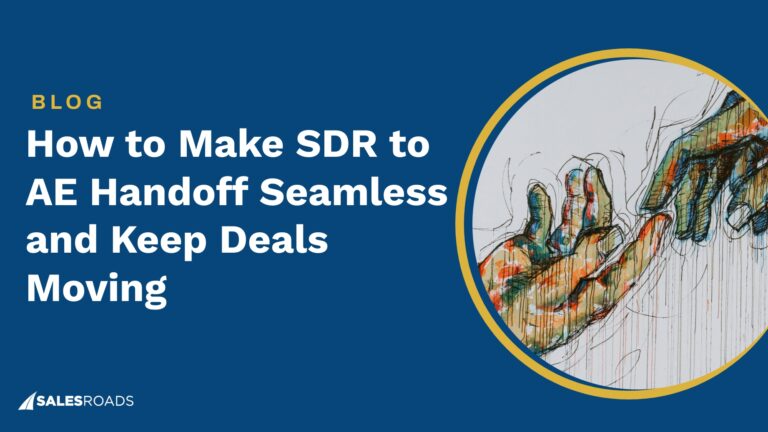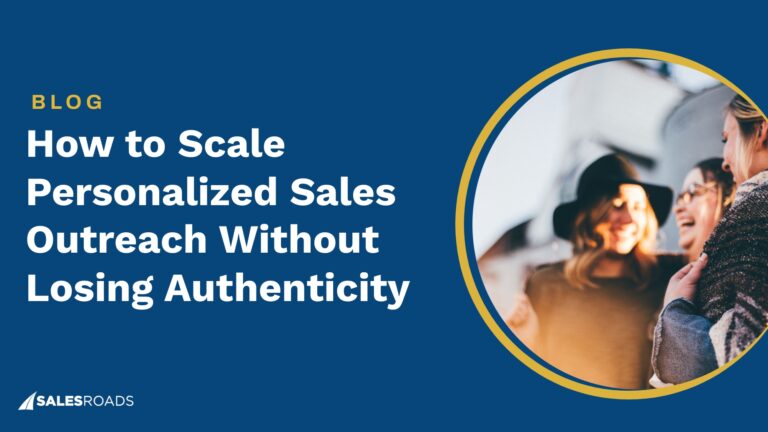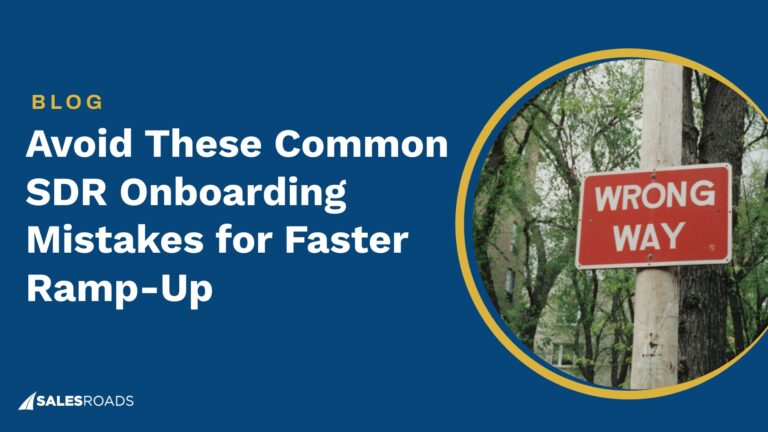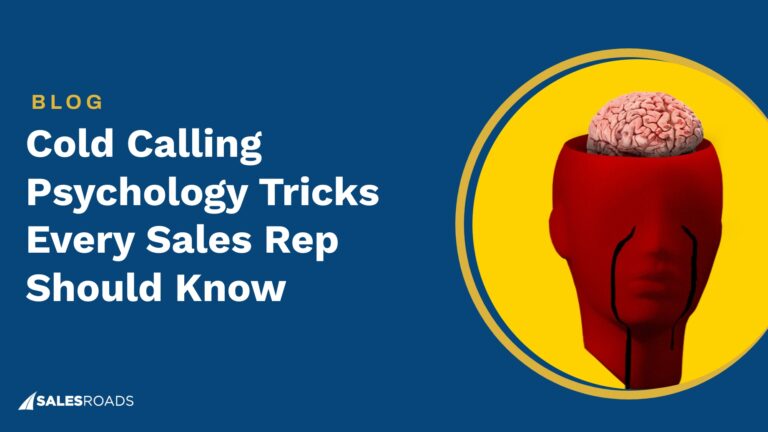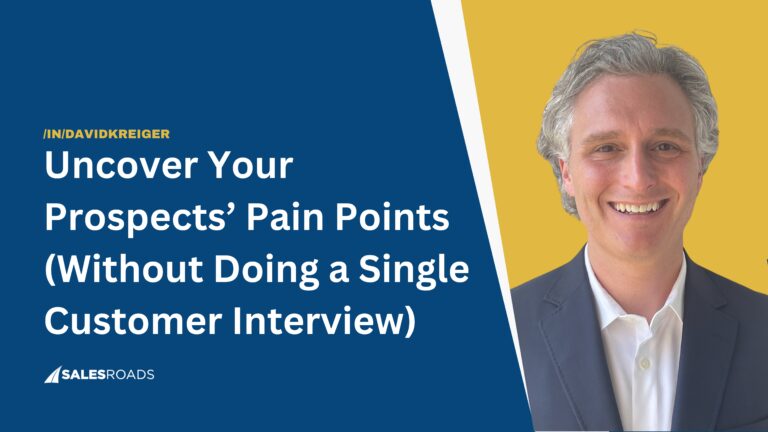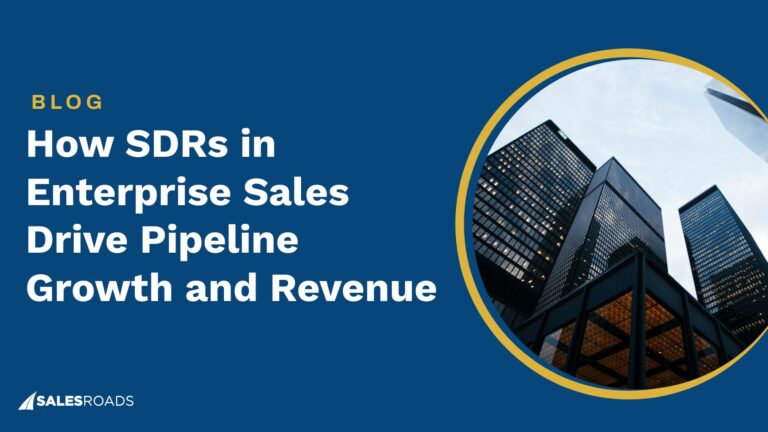Sell Like A Leader – Episode 14
In this episode, we dive into:
– Measuring enterprise sales performance: Managing different levels of performance, understanding the plan and filling gaps, weekly activity sharing for reflection and self-assessment, and monitoring through the right metrics.
– Scaling enterprise sales teams: Focusing on relationship mapping and structuring territory, standardizing decisions to streamline the process, identifying parallels with competitors, and maintaining a good culture while keeping an eye on the sales metrics that matter.
– Rapid Fire Q&A
About David Rubinstein
David Kreiger chats with David Rubinstein, a seasoned sales leader with 15+ years of experience. He started building sales teams at Gen Video before scaling operations at Salesforce for 6 years. He grew the team from 5 to 50 while boosting revenue from $75M to $250M at Outreach and oversaw a team of 50+ driving sales, solutions, operations, and enablement at Kustomer. Now, he is the SVP of Sales at Spark.
Podcast Key Takeaways
- Identify and target specific personas: Rubinstein emphasizes the importance of creating catchy acronyms to help sellers remember and focus on key Personas. This approach fosters accountability and streamlines the sales process.
- Manage performance through sales metrics that matter: Understand your sales plan, fill gaps in strategies, and focus on helping struggling sellers develop their own approaches rather than mandating activities. Encourage sellers to share their weekly activities to drive pipeline, promoting reflection and self-assessment.
- Adapt to changing dynamics in enterprise sales: With the shift away from in-person meetings and the increasing infusion of AI, differentiation through face-to-face interactions becomes crucial.
- Maintain culture while scaling sales teams: Rubinstein shares his structured approach, focusing on ensuring sellers make money, learn and develop skills, and feel good about their impact and respect within the team.
- Master the skill of creating structure: Rubinstein advises everyone in sales to develop an operating rhythm for success, leveraging relationship mapping, understanding company performance, and creating hypotheses to guide prospect interactions.
Connects
Connect with David Rubinstein: https://www.linkedin.com/in/daverubinstein
Connect with David Kreiger: https://www.linkedin.com/in/davidkreiger
Subscribe to the podcast and follow our Podcast LinkedIn page so you don’t miss any episodes!
Transcript
David K: Welcome to the Sell Like a Leader podcast, the podcast for revenue leaders who are on a mission to cultivate a high-performing sales team within their organization. I'm your host, David Kreiger, founder of SalesRoads, the most trusted lead generation and appointment setting company in the country.
Today we are bringing you an amazing revenue leader, David Rubinstein. David is a seasoned sales leader with 15 years of sales leadership experience. He began his career building a sales team at GenVideo before mastering sales at Salesforce for six years. He moved on to Outreach, where he played a key role in scaling the company from 75 million to 250 million in revenue, growing his team 10 times, from 5 to 50 members.
Currently, he leads sales at Kustomer, overseeing sales, solutions [00:01:00] consulting, sales operations, and enablement. Driving strategic initiatives and optimizing processes. David, super excited to dive into sales with you. Thanks so much for being on the show.
David R: Thanks so much for having me.
David K: That's great. And so, today, what I'd love to chat with you about is the right type of activity metrics and managing enterprise sales performance. You have a unique background in managing enterprise sales teams. And a lot of the leaders here who tune into the podcast either are managing enterprise sales, or they want to get their team to start selling to the enterprise level, and would love to get some of the wisdom and lessons learned around managing enterprise sales.
So, where I'd love to start is with metrics. And so something you've called out is making sure that you don't necessarily have the same activity metrics across all segments. And so can you [00:02:00] explain why that's a mistake and how you specifically look at metrics at the enterprise level?
David R: Yeah. So if you have an enterprise account executive, they might have three to five accounts. And so knowing that they sent a hundred emails in a given week really isn't helpful. Does this seller understand the shape of this account? Do they understand the structure?
Do they understand the budget centers that are most relevant to our business? So the first thing that I want to understand from an enterprise seller is how well do you know the business? Do you know how this company makes money? Do you know how they're performing today? Do you know how the business is trending?
Do you know what's holding the business back from being successful? All of those things are important before your product or platform enters the equation. And I think too often sellers get into “this is my product, this is how I can help,” and they go into solution mode.
But what I want to know from my sellers is: how well do you know the [00:03:00] person that you're talking to? How well do you know what matters to them? And that's really the critical starting point for enterprise sales.
David K: Yeah, I think a lot of times we think as sales leaders around specific metrics, right? And how do you manage to the metrics? But what you're saying is, before you even get there, you've got to really make sure that your team understands the people that they're trying to help, the people that they're trying to introduce to your product or service, and make sure that they understand those prospects.
Because if they don't understand them, there's no way that they're going to meet any of the metrics. And so, digging into that just a little bit, how do you approach that type of process with the folks who come on your team? How do you make sure that they're thinking in terms of who their prospects are and making sure that they are understanding who the prospects are and the companies that they're looking to serve?
David R: So the first thing that someone does when they join the team is they get their territory. So AE sits down, they've got their [00:04:00] three to five accounts. How do you map out those accounts? So you start to say, okay, let me build an org chart. And LinkedIn Navigator has made it really easy in order to build out an org chart.
So very easy to do it. So that's something in the first week that someone, while they're still learning the product and what we do, they can start to figure out what does this account look like? Who are the key players? Then they're starting to do relationship mapping.
So they're starting to say, okay, here are all the players here. I've connected with all of the key leaders and board members, and others in our organization. Who do we know? How do we have access? Before we start reaching out, we then have to learn a little bit more about this account. So before you even talk to them, you want to have a hypothesis.
You want to have a hypothesis about how is the business doing? It's really easy when the business is public, right? Everything's out there. When it's private, it can be a little more challenging, but it's still not that hard. Private companies [00:05:00] often have public competitors.
So, first thing you do, you've got an account. You go into ChatGPT and you say, tell me the competitors. So you learn who the competitors are. Oh, these two are publicly traded. Now let's see what information that I can learn about those publicly traded companies.
When I learn that information, it's really easy to start to say, okay, where are there parallels between the company that I'm calling on and these others? Are any of these other companies working with my company? Are they working with my competitor? How are they performing? There's a lot of information that you can do so that you can start to develop a hypothesis, right?
So you know that with enterprise sales, while there may be lots of different ways, paths into an account, each time you could be talking to someone who could really determine your fate in the account. So you often don't get a second chance to make a first impression. So it's important that when you get that meeting, you're ready.
And so I think one of the things that I [00:06:00] focus on with my sellers is, are we ready? What is the hypothesis that we have going into this meeting? So that's kind of an important first step and something that I look for within enterprise sales.
David K: So I have one question to back up, and then I want to move forward, too. So you said you give your team their territory. Are you also asking them to map out the accounts within the territory and figure out the accounts, or do you find it's a best practice to do that at the corporate level and say, here are the accounts that we want you to go after in the territory when a rep is starting out?
David R: I've seen both. Where I've seen the most success is if you keep the seller as focused as possible. So these are the accounts that I want you to focus on. In many cases, with enterprise accounts, there are all sorts of subsidiaries within those enterprises. So a big account could have many accounts underneath it.
But I think it becomes dangerous when you let AEs and AEs create their own territories. Because what will happen is [00:07:00] they will often swipe at an account. I didn't get in, I need more accounts. What's my next account? I need more. Versus, let's figure out how we get in. Like, we picked these accounts for a reason.
We think that we're uniquely qualified to solve problems that they have. And let's figure out how we get in. And that's where I want to spend the time and have my leaders spend the time strategizing with the sellers—how do we get in? Who can we get to that can move the needle?
And that's where we want to focus our time.
David K: Yeah, I find that where you can try to standardize and create decisions for your sales team, the more efficient they can be, while at the same time, finding places where you can empower them and let them work their magic.
Because there are so many times when, as a salesperson, I've gone down that road. You go down a rabbit hole, right? And you're spending all this time trying to research the perfect accounts. If you can lay out the initial workings of where to go, that can save them so much time so that they can then focus on the activities where they can really add [00:08:00] value. And that's where I'd love to dive into.
So you've really clearly mapped out this process where you assign a territory, you assign the key accounts that you want your AE to have. You go and have them map out the accounts and figure out the right people that they should be speaking to, figure out who is connected either through them or through their team or through their network to be able to get into those accounts.
They've mapped out their hypothesis. And then you create your battle plan as you've alluded to. And what are some of the best practices, or how do you coach your team to then, once they've laid all that groundwork, to go in and figure out the best way to prospect into those accounts?
David R: So I think as leaders, we have a responsibility to lay out the who, not just which companies to go after, but who specifically. And what I found is the best way to do it is to come up with some kind of catchy acronym that people can remember, and you can hold them accountable to.
So the first thing I do, and I've done this at multiple [00:09:00] organizations, is I go in and I think about who are the personas that can have an influence on what we do. Take the first letter, I go into a randomizer or word creator—whatever you want to call it—and say, tell me a word, the words that have these letters in them.
So I did that when I got to Kustomer, and I came out with POISE, right? So for us, the personas are Product, Operations, IT, Support, and Executive. It's very easy for me to say to a seller, how are you doing against POISE? Oh, it looks like you have your P and your I, but you're missing the O and the S, and E.
How are we gonna get there? What are our steps? Have we identified who they are? And let's talk about the value proposition or our hypothesis about what each one of those personas is going to care about. So any business can do it, but it's important that it's done in a way that sellers can remember.
We ask a lot of them. So the [00:10:00] easier you can make whatever your ask is—something that's memorable—it really makes a huge difference.
David K: Yeah, I love acronyms, and ChatGPT has made acronyms so much easier to create this day and age. As leaders, it's important both to train around a process, but then make the process easy to remember, both for us—folks who are executing on the process—but also for those who are managing to the process. Because sometimes the managers also need something to remind them, what are the things they're supposed to go over with their team and coach on, and things like that.
And so you've outlined the different folks. They've got individuals that they are going after. How do you break down the AE prospecting? What do you expect of your AEs to prospect? I don't know if you have BDRs or SDRs at Kustomer. How do you break that down?
And then at that point, I know we started at the beginning here, looking a little bit more strategically, looking beyond the metrics, but how do you then bring in metrics to know that they are [00:11:00] executing, that they are reaching the right activity levels and things like that?
How do you manage when you've got an organization that you need to at least have some form of dashboard to be able to know what's working and what's not working?
David R: Yeah, it's a great question, and it's a little bit of art and it's a little bit of science. I think that the metrics matter most when someone is having a hard time. And so if you look at the team and the team's performance, if you've got multiple enterprise account executives, you have one who is fully penetrated into their accounts.
They've identified multiple opportunities. They have a demonstrated ability to close business. And they have deals that are on a path to close. Is that a seller that you want to spend a lot of time leaning in going, hey, how much activity have you had? What have you done?
Or is that one you want to spend your time kind of talking strategy about, and going, how do I turn this $1 million deal into a $5 million deal? And what are the things we can do? So I think for me, when we talk [00:12:00] about enterprise, you start to go deeper in metrics with those that are having a harder time, right?
So if you start to look at your team and you've got people that are thriving, people that are getting by, and people that are struggling, I think the people that are thriving—you help them get more, you help them grow what they have, you help them go deeper in the accounts.
But you maybe are less worried about activity. When you have the people in the middle, it's about understanding what is their path to get to their number and beyond. And in many cases, when someone does a territory plan, you can see where they're going to get to.
You can see what pipeline they have, and you can see what gaps they have. And so, rather than measuring the number of activities, I'd rather understand the plan. So if I have a seller who has 2X coverage on their [00:13:00] quota and our business might require 4X coverage, I want to know what they're going to do to fill that gap.
And so the way that they fill that gap based on the territory that they have might be different. They might have a territory that has a few big opportunities, and it's about surrounding those few big opportunities. And that's where the pipe's going to come from.
I might have another seller who also has a gap, but the way that they get to their number looks radically different. They have an existing customer who's doing well, and that company has a bunch of smaller subsidiaries. And we think there's an opportunity to navigate those subsidiaries in order to fill the pipe and cover it there.
For that seller, the way that they get to their number might look very different. And so it's really about having a plan and following the plan and giving the account executive the opportunity to develop that plan and own it.
And so what I like to [00:14:00] do with my sellers from a pipe gen perspective is ask every Friday, could you send me and your direct leader what you did this week in order to drive pipeline? And I'm not micromanaging. I'm just asking to share what they did. And what I've found is that by not demanding certain activities or volume, people have pride with how they spend their week.
And do they want to send a note to their boss's boss at the end of the week that says, I sent three emails? Or do they want to show up well?
And you learn a lot about your team with how they choose to show up when you're not mandating they do it. And then what you do is—there will always be people that are struggling—and for the people that are struggling, you look at what the activity is.
And you ask them, you're just like, hey, look, how do you feel like this is setting you up for success? I noticed that the last few [00:15:00] weeks you've done this, and it doesn't appear to be driving pipeline. What do you think is the best way to adjust your strategy going forward? And really get them thinking.
And then if we need to, we can sit down. But I've found that letting the AEs define what their strategy is gets a remarkable amount of creativity. And then I take that and I share that with others. And I say, hey, look what Mary’s doing or Tom’s doing.
This is phenomenal. Steal this. Look forward to seeing everybody's notes next week—maybe some of the successes that they've seen their teammates do.
David K: I love so much of what you said. So there's a lot to unpack there and dive into, starting with the notes, because I think that is a really creative way of managing on so many different levels. Because so many managers do manage to the metrics. And especially I think in enterprise sales—but it could be argued in almost any type of sales—when you do that, it can feel like micromanaging.
It can be disempowering. [00:16:00] And then also people are going to generate the metrics that you're watching, even if they aren’t the ones that are going to necessarily lead to more pipeline or closed-won. You are letting them drive while also they're knowing that you're watching, but you're not necessarily watching what you want to watch.
You're giving them a chance to show what they're doing and why that makes sense. The other part of it is I think, that the best salespeople and the best executives are those that are self-reflective. And you're instituting that for your team, where on a Friday, not only are they giving information to their boss's boss, but it gives them an opportunity to reflect on their week.
And they might be like, wait a second, this wasn’t a very productive week. They might put the most positive spin on it as they email you, but it's forcing them to reflect and think about their week and how they could have maybe better organized it.
Or, on the flip side, if they had some wins—to celebrate the wins—and really feel good about some of the things they created. So I think it’s a wonderful mechanism that I frankly haven’t really heard before [00:17:00] in this format that I really do love.
David R: What I would share is that having spent six years at Salesforce, I love a good dashboard too. One of the things that we lived in was what we called an AMP dashboard, which was: Activity, Meetings, Pipeline. And I think where I was focused is—you start with end numbers, right?
Is someone performing? Are they driving business? And if their deals are closed, coming in, if they have a healthy business running, I'm less worried about how they show up on an AMP dashboard. Obviously, I always want people to have more pipeline, but I'm less worried there.
The first thing I look at is pipeline. And I look at pipeline for each of the sellers. As a leader, you should know what's real and what's not.
So let’s assume that seller A has a significant amount of real pipeline. I'm feeling pretty good there. I'm gonna move on to seller B. Seller B doesn’t have as much pipeline. So the next thing I look at is I look at meetings.
And I want to understand, are they getting in front of [00:18:00] customers? Because if they’re getting in front of customers, I feel much better about the potential that the pipeline that they have is real and can progress. If they don’t have meetings, that starts to be more concerning to me.
Now, the world today is different than it was three or four years ago, right? And I think this is an inflection point for enterprise sales, where people have gotten very comfortable selling in their pajamas the last few years, and many people closed the biggest deals in their career from their house, right? Without ever meeting a customer.
We're going back just a few years, that every deal above a certain size, you were meeting with the customer on site, and your competitors were as well. So being in front of a customer was table stakes. Everybody was doing it. Over the last few years, that has changed materially.
The challenge that we have today is that [00:19:00] everyone is infusing AI into their products. And what you're starting to find is that differentiation across products is more and more difficult for a buyer to discern. You have a bunch of sellers in their pajamas, selling products that sound very similar to what others are selling.
So I believe where the world is going is if you're actually in front of customers, it's no longer the norm. There is a window of time for enterprise sellers where if you can find a way to get on site—and it's not always easy because in many cases, these folks are working remote, they're not going in an office, the team is scattered—but if you can find a way to do that, I believe enterprise sellers will have a significant advantage for some period of time. Before the world shifts back to sellers realizing you have to be in front of customers to sell to them.
David K: I think it's a really [00:20:00] compelling point. I've talked to a few folks, sales leaders, who've tried to put budget behind travel for their team. They're amazed at the number of reps who just don't want to do it. It's a different world, like you said, it used to be table stakes.
And I think you make a very compelling point that because most sellers don't want to do it now, because like you said, a lot of buyers don't want to go into the office—they don't want to spend the time with a salesperson anymore.
But if you can find a way to do it, it is a true differentiation. And a real opportunity to be able to dive in more strategically, like you said at the beginning, with that customer. Because there's only so much you can do on a Zoom call.
But when you're sitting across from them—or better yet, if you can get the team in a room—it's just a very different dynamic. And at the end of the day, that's really what great selling is all about: being there, building that rapport with your client, getting them to trust you, and strategizing with them. What you say rings true, that there are certain times and places, [00:21:00] certain types of deals where there's just no replacing face-to-face contact.
David R: And especially if products start to morph into their competitors and start to look very similar, what are buyers going to choose based on?
David K: I think that is really important. And as enterprise sellers, especially as they're thinking about building their team, if they can build that into part of their sales process or the culture, they can really stand ahead of their competition.
And slightly to that point—you've scaled sales teams rapidly and built processes that have worked—but as you are scaling your enterprise sales team, what are some of the things that you lean on, or certain things that have helped you to maintain a culture, or things that haven’t worked as you've scaled multiple companies?
David R: Yeah. I think the most important thing as a leader, when you come in, particularly in a new organization, but really in any organization, is no one cares how much you know until they know how much you care. And that's really important [00:22:00] for everybody to realize. So it's a natural thing.
You come in as a leader, you're watching your new team perform, and you're like, "Oh, they could do that better and that better, and I'm going to fix this and fix this." But no one wants to hear it because you don't know them. You don't know their journey. You don't know their priorities. You don't know their strengths. You don't know their goals or their challenges. You don't know anything about them.
So any feedback that you provide out of the gate can have a negative effect. And so it's really important for that person to get to know you. So I think what I do when I first start out working with someone, there are a couple of things that I do.
One is, I let them know what's important, right? And what are the things that I look for? So they have that context. And for me, there are three things. There are three things that are important.
One is, I focus on: are the individuals on the team making money? Because if your sellers aren't making money, they will leave. And the majority of us as leaders, over the [00:23:00] course of our careers, have at one point or another had a team that hit its number because one or two sellers closed a few big deals and crushed it. And the other people on the team starved. But we got to the number, and everyone high-fived, but the majority of the team didn’t make it.
And to me, that's not a success. The metric that I look at is AE participation. Are my AEs getting to 75 percent of their quota in any given quarter? And if they are, I look at them as participating. And if they're not, I look at what do I need to do to help ensure everybody's participating.
So the first thing is, are people making money?
The second thing is, are they learning and developing skills? When I was at Salesforce, we would change our teams every single year. So every year you'd have a bunch of sellers, certain half of them would get promoted, a few of them would decide to join other sales teams within Salesforce, and you'd have a couple people stay.
So [00:24:00] effectively, everyone on your team was a one-year rental. And so what I started to think about is how do I make sure that if someone's only going to spend a year with me, how do I make sure that year has an impact on their career?
And so I look at that now with everyone that I work with. And I say, "Hey, you're pretty good right now, but if you're the same type of seller a year from now, then I've failed." So, how do we make sure that you're progressing and you're growing?
And the third thing that's important to me, and I want people who are on my team to know, is: I want you to feel good when your head hits the pillow at night. Do you feel like you're making an impact? Do you feel like you're respected? Do you feel like you're appreciated? Do you respect and appreciate your teammates?
And building that kind of culture where it's a "we" culture versus a "me" culture. We're all super competitive—we're in sales—but when the person who's number two on the dashboard closes a deal and gets above you, are you upset because you're not number one, or do you call [00:25:00] that person up and congratulate them?
And that's what I want in the teams that I build. So those are the three things that I look for. And I share that with sellers, usually in a first meeting.
David K: That's fantastic. I love, again, you have structure around it too. So everybody knows that there's three things, because culture can be evasive and it can be difficult to instill. And when you have three things that you're focused on to be able to scale that culture, I think that is fantastic.
Well, what I'd love to do before I let you go, though, is do what we call our rapid-fire questions. And so we ask the same questions of each of our guests and would love to just get a sense from you—what comes into your head—and we can all learn from your insights.
So are you ready?
David R: Yeah, let's do it.
David K: All right. So, what is one thing people don't give enough value or attention to in leadership?
David R: I would say connecting with the team and the right way to provide feedback. I think often people jump in and provide feedback. They don't ask for permission—"Is it okay if [00:26:00] I provide you with some feedback?" I think they just dive in. They provide something that someone wasn't ready to receive, and I think that can be detrimental.
David K: Yeah, I couldn't agree more. When I went to business school, I had all these CEOs come and speak to us. And they'd always talk about culture. I'm like, "Oh, it's such fluffy stuff." And now that I've run my own organization, I realize how important culture is in motivating, finding the right people, keeping the right people.
What is one skill you advise everyone in sales, leaders, or non-leaders?
David R: I would say structure is really important. When I think about the people that I work with and for—and the best ones that I worked for—always had an operating rhythm that allowed them to be successful. So the less you have to think in your day, week, month, quarter, I think the more successful you'll be.
I think the best leaders—and sellers, for that matter—carve out time. They carve out think time. But their day, week, month, quarter [00:27:00] is mapped out for them. They have anchors throughout.
Anyone who's on my team knows that at the midway point of the quarter—and we're on the Salesforce fiscal on June 15th—you've got to provide your forecast for the next quarter. The more of those things that you have over the course of 90 days takes the thinking out of it and just allows you to operate and run a business. I think it's something that is a skill that's invaluable for everyone.
David K: What's your favorite business, leadership, or sales book?
David R: The One Thing by Gary Keller. What's the one thing that you can do that can make everything else in your life or in your job easier? I had an opportunity to live that book when I got to Outreach. It was March of 2020. So everything was just starting, and I had started a new job.
I just left Salesforce. People looked at me like, "You're leaving Salesforce at the beginning of COVID? Like what's wrong with you?" And it was a big risk. And I got to the new job and I thought, all right, what's the [00:28:00] one thing I got to do to be successful? And my job was to scale a team that was five people and grow it as fast as I could.
Yet, I didn't know the business, and normally, the way we onboarded people is we flew them to Seattle, but we couldn't do that anymore. So people said, don't worry, there's some AEs on your team who know it pretty well. They can help you onboard. I've always been a believer that in order for something to be successful, you have to have someone own it.
And so I went to our CRO, Anna Baird, and I said, I know I'm the new guy, but I got a crazy idea. I'd like to steal one of the West Coast RVPs and have them join my team. If they can work East Coast hours, I'm totally good with it.
I'll give them the best career experience of their life. But I need someone who knows the business, who can partner with me. And we did it. We partnered together, and we grew the business from five to 50. But that was all from the kind of the concepts that Gary has, which is, what is the one thing that you can do to make everything else [00:29:00] easier?
And that was my one thing. And so in any job I have, I'm always thinking about what's the one thing.
David K: I love that book. And at SalesRoads, as part of our coaching sessions, we make sure that the SDR coaches always work on a one thing to come out of that coaching session. Because a lot of times you can throw so much stuff at sales reps, they can have ideas of what they want to implement.
But we say, listen, take time to figure out what's the most important thing to work on to help you hit or achieve your quota. So I'm right there with you. What's your favorite quote, mantra, or saying that inspires you as a sales leader?
David R: People fail, not because they aim too high and miss, but because they aim too low and hit. So if you think about that, we've all heard over the course of our careers, under promise and over deliver. There's a number that I could give my CEO to say, I am certain that my team will close 50,000 this quarter.
And if we think we're only going to close this amount, then we start slowing down hiring and other things. And [00:30:00] so there's a point where it becomes counterproductive to throw out something that you know you can hit. That's a sure thing. I think our job as leaders is to help make people comfortable being a little bit uncomfortable.
And putting out a number that maybe they aren't 100 percent certain of, but you know what? They'll figure it out, and I'll help them figure it out. And their teammates will help them figure it out. But if you put out a lowball number, you can't feel good about hitting it.
David K: And lastly, what is the most important goal or project that you're working on right now, David?
David R: Again, scaling the business. Being able to consistently hit numbers every quarter, growing the team. I think what I have the most fun of in my career is scaling, and is not only scaling, but helping people up-level their careers and change their lives. If we're able to help people make more money, that can have a material impact on their lives and how they support [00:31:00] their families.
And I have a lot of pride in looking back on AEs that I've worked with that are now having their best years, or now are leaders or second-line leaders.
I think that makes me really proud.
David K: David, thank you so much for coming on the podcast. Lots of great insights for sales leaders looking to scale an enterprise sales team, a sales team in general. If folks are looking to connect with you, have some questions, where can they find out more about you?
David R: LinkedIn is probably best place. Dave Rubinstein on LinkedIn, you'll find me.
David K: Fantastic. All right. And for listeners, thank you so much for joining another episode here. Take care. If you liked what you heard, please don't forget to subscribe on your platform of choice. And as always, I'd love to hear your feedback, reach out anytime.
I'm active on LinkedIn at David Kreiger. And to learn more about the work we do at SalesRoads, you can always go to SalesRoads.com. Thanks so much for listening.
Thanks so much, Dave. Really appreciate the time.


